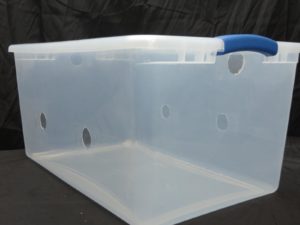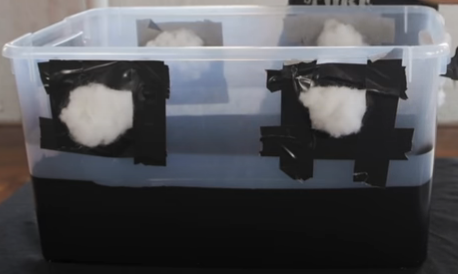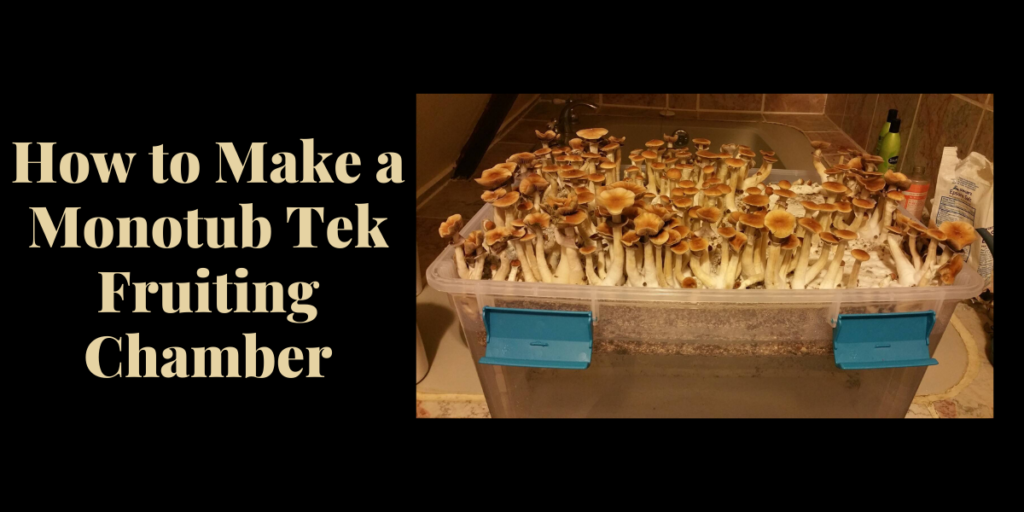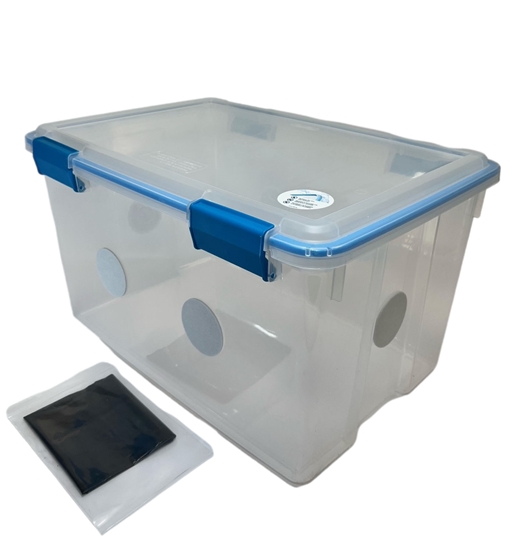A monotub[i] is a simple but effective fruiting chamber for cultivating or growing magic mushrooms. “Tek” means method or technique (it’s short for “technique”), so monotub tek is simply the method that works with a monotub, as opposed to a shotgun grow chamber.
Monotub tek was developed by growers of (illegal) hallucinogenic mushrooms. Those Species (Ex. Psilocybe Cubensis strains) grow well in composted horse manure mixes, so that is the substrate typically used in monotubs. Several edible species, including crimini/portobello and the ever-popular white button, also feed on manure and can grow well in exactly the same set-up. Alternatively, a monotub can be filled with other substrates—several oyster mushroom species will grow well in monotubs filled with woodchips.
Monotubs are a good option for professional growers who are just starting to establish themselves, since they can yield much larger harvests than mushroom grow kits, but don’t require the investment of industrial scale. And as business increases, it’s easy to just add more monotubs. Another advantage is that, unlike mushroom grow bags, monotubs are re-usable, so there is less waste.
A monotub is basically a large, plastic tub with air-holes in it. What follows is a basic guide for building a monotub. Actually using the monotub to grow mushrooms is fairly simple and straightforward, but it’s beyond the scope of this article.
Materials Needed:
- One large, clear plastic tub with a lid.
- Black spray paint suitable for use on plastic.
- A heavy-duty pair of scissors or gardening snips OR a drill with a two-inch hole saw bit.
- Poly-fill or equivalent.
- Duct tape or other heavy-duty tape.
Step by Step Instructions on Creating a Monotub Tek
There are many possible variations on monotub construction. This version is workable and simple, but growers should feel free to improvise.
Step 1: Assemble the Materials.
Note that it’s possible to use an opaque tub, but then a window must be cut in the lid and covered with some translucent material. Fungi don’t need light for energy, the way plants do, but they do need to find out where the outside of the substrate is so they know where to form mushrooms, and light is an indication of “outside.” Most fungi don’t fruit in utter darkness.
Step 2. Paint the Lower Half of the Tub Black
Paint only the outside of the tub, and only the lower half—the tub will be filled with substrate up to the paint line, and the purpose of the paint is to keep light from shining on the substrate except on the top. Without the paint, the fungi will sense the light coming through the sides and will try to make mushrooms up against the tub walls beneath the substrate surface. It’s almost impossible to harvest those mushrooms, and their growth will take energy away from the mushrooms growing at the surface. Painting the tub keeps the fungus from getting confused about where to make mushrooms.
Step 3: Make Air-Holes
Fungi need to breathe, and they also use fresh air as another indicator of “outside,” meaning that a fungus without adequate access to fresh air won’t fruit, or will produce only poorly-formed mushrooms. Some set-ups include fans to increase air exchange, but the holes should be adequate. The rule of thumb is one hole per eight inches of length, meaning a three-foot-long tub needs
four or five holes in each long side, plus at least one hole on each short side. Remember to put the holes above the paint line only!
Each hole should be two inches across. They can be drilled with a power-drill using a hole-saw attachment, or cut by hand using a pair of scissors or gardening snips.
Make sure your holes are above where your substrate will be.


Step 4: Seal the Holes with Poly-Fill
The whole reason to use a fruiting chamber rather than an open tub is to prevent spores from other fungi coming in and contaminating the substrate. Such contaminants are essentially weeds, and just as in gardening for plants, weeds are a problem because they compete with the crop for resources. Plus, if the weed fruits and its mushrooms happen to resemble the crop, they might be harvested by mistake—a serious problem if the weed is toxic! And, unlike with plants, weed fungi can’t be pulled out because their mycelia cannot be removed from the substrate or disentangled from the crop’s mycelium. Weeds must simply be excluded from the beginning, which is why the inside of the fruiting chamber and the substrate must be sterilized before use. So, how to keep weed spores from coming in through the air-holes?
Some sort of microfilter is necessary, and one of the simplest options is to just stuff some poly-fill in each hole. It admits air but not spores. Use heavy-duty tape to keep the fill in place.


Lastly if a Monotub Tek seems too complicated for you, look into PF Tek, Dub Tub Tek, or WBS Tek.




Interesting concept for a small scale grower
It sure is Dianne! It’s why so many people love the Monotub Tek method!
This is a very good idea.
I would use Al foil on the outside of the tub instead of paint. But I live where it’s cold.
Also, I would spend 10 bucks and buy actual micropore paper.
The paper comes in many sizes. For the 1/4 inch I would put 4 equally spaced holes in the short end from a fith hole in the center. I would go for 8 holes on the long side. 3 in a line on top ( about a half inch below the mold line) and bottom (2 inches above the substrate +/-). Two in the center equidistant from each other.
Making one like this now. I will post a pic. Later.
Thanks for the feedback Spencer! Let us know when you finish yours!
What I was thinking. I prefer micropore in past, and it is very cheap and more reliable than polyfill.
Painting the bottom of the tub black doesn’t do anything useful. Specifically, it doesn’t prevent what’s called “side pins ” — when mushrooms fruit on the side of the cake, up against the side of the tub. It’s a pain.
They fruit that way because as the cake shrinks, a space is created between the cake and the side of the tub. This small space tends to have an ideal little microclimate for fruiting.
So what you do is use a liner — cheap plastic garbage bag (not a thick contractor bag). As the cake shrinks, the liner adheres to the cake, and so prevents that space from forming.
Great idea.
Ohhhhh Thanks for that information. I was getting ready to set up my mono tub and use “disposable” Aluminum pan liners. Now that I understand the science, it makes total sense to use plastic!
i have designed a still air box/glove box inoculation chamber to be used as a incubation chamber using uv c diode strip lights to assist in handling bacterial and spore contamination during cultivation attempts. it is to be used 30 minutes before inoculation attempts after all outside air is cut off, no motion of air insde box. Seems this has not been utilized yet. Sounds good on paper, your thoughts are welcome, thx! ps this is a new application but an old idea, uv c light kills germs and molds the most common forms of contamination.
Do it! SAB’s (Still Air Boxes) are AMAZING for inoculation, amongst other things, if you dont have a flow hood! I always inoculate inside my SAB!
Electrical (lighting) engineer here! UV-C at the appropriate wavelengths is great for clearing open air and surfaces of all sorts of microbial life. Short term exposure to the light is okay but do not stay in contact with the light for safety. This will have very limited efficacy on microbial life in your substrate though as the light will not penetrate the surface, so make sure to sanitize/pasteurize/whatever your method is for your particular substrate in addition to the light! Great idea, I’m going to steal this one for my next grow. I honestly would be curious about using this after moving spawn to a fruiting chamber… I imagine the mycelium would survive with no issues other than the very top layer while everything in the air would be purged after the recommended run time for the light. Definitely test that before implementing though… I don’t have any test data on that last idea 😉
Love it! My first monotub is currently colonizing as we speak! Hopefully i can flip to fruiting soon!!!